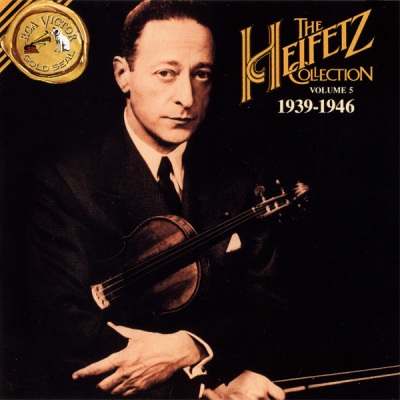
The Heifetz Collection Vol. 5 - 1939-1946
If Frank Sealy has a place in musical history, it is because he was the organist who shared the stage of Carnegie Hall in the performance of the Vitali Chaconne that began Heifetz's American career. This is as inconspicuous a starting point as can be imagined for a list of Heifetz collaborators that grew to a Who's Who of performing artists over five decades. In no small way the recordings present a history of performing partnerships over half a century. Partnership can, of course, include senior, junior and even silent partners. The key to the art of collaboration is finding like-minded persons to share whatever phase of the repertory is at issue. Partnership in performance has rarely reached greater heights than in the December 1939 sessions that brought together Heifetz, the great Philadelphia Orchestra, its then new music director Eugene Ormandy and cellist Emanuel Feuermann. Least known to today's public is the unforgettable Feuermann. Of Galician birth, he was at his career's peak when this recording of the Brahms Double Concerto was made. It is a cruel reminder (along with the trio recordings with Heifetz and Rubinstein) of great hopes left unfulfilled, for he died three years later, at the age of 39, from a complication after routine surgery. Feuermann commanded his instrument in a way that enabled him to share phrase by phrase, surge by surge, his partner's every impulse. Tonally, the two soloists shared a sound so similar that the "registers" (to ue a vocal term) are unbroken from the lowest reaches of the cello to the highest of the violin. As of 1939 Ormandy was still known to many musicians as an ex-violinist who had risen to the command of the Minneapolis Symphony Orchestra and, by a striking exercise of administrative foresight, had been chosen to succeed Leopold Stokowski in Philadelphia. It was such recordings as this (and others with such artists as Rachmaninoff and Kreisler) that gave Ormandy recognition not only as a worthy master of a great orchestra but as a man with a rare, special flair for collaborating with his greatest colleagues. Here, too, the hall is part of a collaboration: the walls of the Academy of Music are all around a reproduced sound then rated as a standard by which all others could be measured. Rarest of these collaborations is the one, the only, reproduction of a Heifetz-Toscanini performance. Its source was a historic happening of the mid-'30s, when Heifetz shared the stage of Carnegie Hall and the Beethoven concerto in a benefit concert on April 29,1936, marking the end of Toscanini's tenure as music director of the New York Philharmonic. In their reunion of 1940 Heifetz and-Toscanini broke new ground for the recently organized NBC Symphony Orchestra in the first concerto collaboration of many to come with other great artists. Much as recording modes have changed, the results present an extraordinary insight by two great interpreters into one of Beethoven's greatest works. Noteworthy, too, is the rarely heard, even more rarely recorded, Chausson concerto, with the Musical Art Quartet and Jesús Maria Sanromá as pianist. In finality, however, the most enduring impulse of Heifetz in this period was his commission to William Walton for a concerto, here heard as it was performed in its disc premiere with Eugene Goossens and the Cincinnati Symphony Orchestra in 1941. When the recording first appeared I wrote that it was "a work designed to be played and replayed"—an opinion confirmed not only by a later version by Heifetz himself but also by other violinists, some unborn when it was written. —Irving Kolodin
